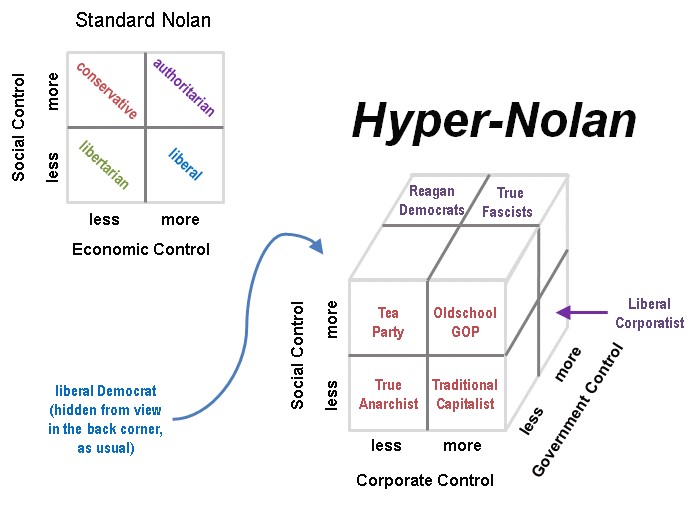Many of you are familiar with the Nolan chart: a simplified two-by-two illustration of political groupings in American politics. One axis divides the square into regions of more or less social control, while the other axis divides the square into regions of more or less economic control. Together, they produce four quadrants: liberals (more economic control, less social control), conservatives (more social control, less economic control), libertarians (less of both), and authoritarians (more of both).
I believe that this traditional Nolan chart is inadequate because it does not distinguish between government control of people and corporate control of people. If we expand the Nolan chart into three dimensions–forming a cube or a “Hyper-Nolan”–we can get a much more complete picture of the many groups that currently populate the American political landscape.
The three dimensions of the hyper-Nolan are social control, corporate control, and government control, each one divided into a region of “more” or “less” to produce eight quadrants.
- The True Anarchist (less social control, less government control, less corporate control). This is a true idealist’s case, and only seems really possible for a hermit living in the woods. It conjures stereotyped images of quaint villages where everything is run by family businesses and nobody cares what anyone else does as long as it doesn’t interfere with other people. The true hippie ideal that works brilliantly until marauders on horseback come along and enslave everybody because they aren’t organized enough to defend themselves.
- The Traditional Capitalist (less social control, less government control, more corporate control). Everything is controlled by the free market, which means everything is controlled by the decisions of the “capitalists,” which (in traditional capitalism) means the people with the capital. In other words, the people who have all the money. Capitalism left completely on its own always builds up monopolies and corporate power structures that limit people’s options and end up limiting people’s freedom: thus, more corporate control.
- The Liberal Democrat (less social control, more government control, less corporate control). In order to prevent the corporation-dominated “traditional capitalist” scenario, the Government steps in for “the good of the people.” Government regulates business, breaks up monopolies, and generally protects people from harm… but naturally limits people’s freedoms in the process. But it is all justified because the limitations are there to protect you from the evils that arise when capitalism runs amok.
- The Liberal Corporatist (less social control, more government control, more corporate control). Some people have argued that the United States has evolved into a “liberal corporatist” system. While economic policy is still fairly socially liberal (at least by comparison to some places), it is heavily skewed in favor of both government regulation and corporate power. For the people who argue that America is a liberal corporatist system, they see the “push and pull” relationship between government regulation and corporate interests as having been undermined by lobbyists and big money in government. As a result, corporations and government now work together, and mutually control people instead of protecting people from each other.
- The Tea Party (more social control, less government control, less corporate control). Although the Tea Party tried to sell itself to the public as a purely economic movement, let’s face it: for the most part the movement has been composed by people who are as bigoted and culturally narrow as the 1700’s culture that inspired their costumes. They certainly don’t want to be controlled by government, they also don’t like the idea of being controlled by big companies, but let’s make sure everyone is white and talks about God a lot.
- Old-school GOP (more social control, less government control, more corporate control). The traditional establishment wing of the Republican party. They hate government, they love corporations, and they want to make sure you aren’t sinning in the bedroom. They are mostly old rich white guys, and people who aspire to some day become old rich white guys (for example, Ann Coulter).
- Reagan Democrats (more social control, more government control, less corporate control). The only difference between the Liberal Democrat and the Reagan Democrat is the Reagan Democrats are social conservatives. They are pro-union and want the government to come in and break up the power of the corporations, they are all in favor of the government protecting the “little guy”. But they also are religious, traditional, and don’t really want people who are too different from themselves hanging around. At least, not after dark.
- True Fascists (more social control, more government control, more corporate control). This is the opposite end (because we are talking about a cube, the “diagonal”) from the True Anarchist. For the True Fascist, the individual is completely subservient to the needs of the group. Individuals must conform to strict social norms, and economic lives are under complete control of the dual powers of their employer and the government (probably working together). Really, the only difference between a True Fascist and a Liberal Corporatist is that the Fascist also wants to control your religion and your sex life. Meanwhile, the only difference between the Fascist and the Old-School GOP is the addition of government regulation.
The hyper-Nolan provides what I believe is a more complete understanding of our political landscape, and highlights some very important differences between different ways in which people can have freedom… or can be controlled.
Which of the 8 groups in the hyper-Nolan describes you?


